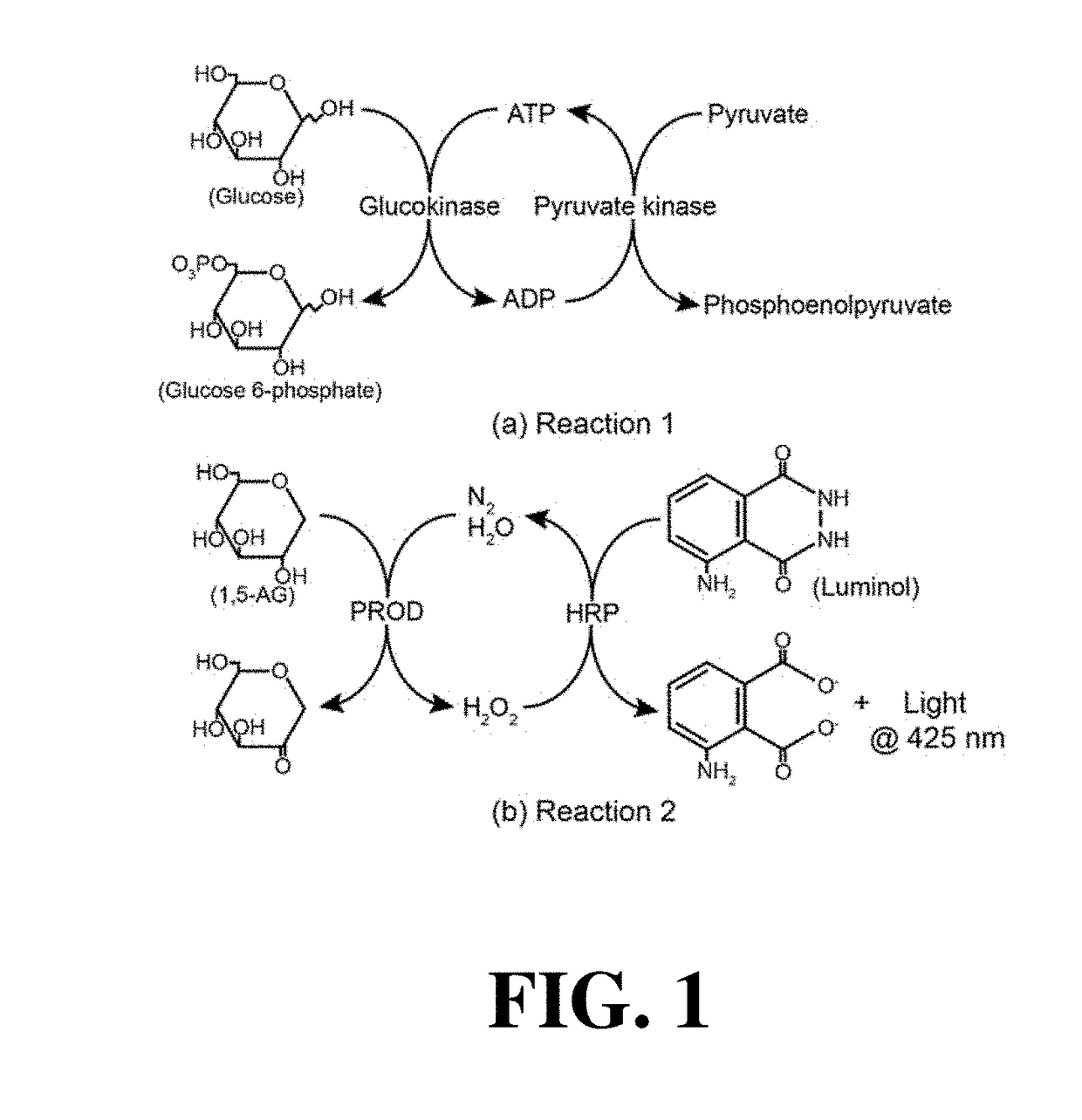Systems and methods for detection of chemiluminescent reactions
a technology of chemiluminescent reactions and systems, applied in the field of systems, can solve problems such as interference with 1,5-ahg measurement, large sample volume, and series of sample preparations
- Summary
- Abstract
- Description
- Claims
- Application Information
AI Technical Summary
Benefits of technology
Problems solved by technology
Method used
Image
Examples
example 1
of 1,5-AHG with Enzymatic Reaction Pretreatment
[0118]Early diagnosis of type 2 diabetes (T2D) is paramount important to reduce the complications of diabetes. For the glycemic monitoring in T2D, one can measure metabolic analytes, such as 1,5-anhydroglucitol (1,5-AHG), HbA1c and glucose in blood samples. Recent report has revealed a strong association of T2D with 1,5-AHG in saliva as a noninvasive marker, resulting in benefit of patients who adverse to blood sampling. 1,5-AHG is unmetabolizable glucose analogue which is present in human blood due predominantly to dietary ingestion. In physiology, 1,5-AHG level is balanced by being reabsorbed and excreted through kidney and urine, respectively. Normal range of 1,5-AHG level in human body is around 6.8-32.3 μg / ml. 1,5-AHG concentration in blood decreases during times of hyperglycemia, since reabsorption is completely inhibited by glucose at fructose and mannose active transporter; Therefore, monitoring 1,5-AHG in saliva is useful in ac...
example 2
of 1,5-AHG with Chromatography Column
[0123]In an example, sample is run thru a chromatography column, such as ion exchange, HIC, metal chelate, boronate, or affinity, to remove glucose and other interferences. The eluent containing 1,5-anhydroglucitol is mixed with 10 μL of pyranose oxidase for 5 mins at room temperature. After the reaction of pyranose oxidase and 1,5-anhydroglucitol, 30 μL of luminol solution and 1 μg / mL peroxidase are added to the 1,5-AHG solution, followed by light intensity measurement using the point-of-care (POC) photon detector.
example 3
l Sample Pretreatment to Remove Interferences
[0124]Depending on the sample sources, the presence of some monosaccharides can interfere with the 1,5-AHG detection assay. Some of the known interferences when using pyranose oxidase as 1,5-AHG detection enzyme include: D-glucose, L-sorbose, D-xylose, D-galactose, glucono-δ-lactone. The complexity of pretreatment varies with the type of body fluids. Normally, with blood sample, D-glucose is the major interference and the pretreatment methods were described in example 1 and 2. For samples from other body fluids, a mixture of enzymes is used instead of just glucose oxidase. Such enzyme mix contains enzymes that can convert or modify the interferences to non-interfering molecules. An example of composition of the enzyme mix includes glucose oxidase, L-sorbose oxidase, D-xylose oxidase, D-galactose oxidase, glucono-δ-lactone oxidase.
PUM
| Property | Measurement | Unit |
|---|---|---|
| area | aaaaa | aaaaa |
| current | aaaaa | aaaaa |
| concentrations | aaaaa | aaaaa |
Abstract
Description
Claims
Application Information
 Login to View More
Login to View More - R&D
- Intellectual Property
- Life Sciences
- Materials
- Tech Scout
- Unparalleled Data Quality
- Higher Quality Content
- 60% Fewer Hallucinations
Browse by: Latest US Patents, China's latest patents, Technical Efficacy Thesaurus, Application Domain, Technology Topic, Popular Technical Reports.
© 2025 PatSnap. All rights reserved.Legal|Privacy policy|Modern Slavery Act Transparency Statement|Sitemap|About US| Contact US: help@patsnap.com



